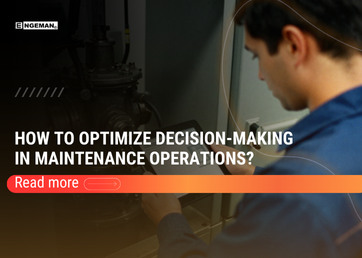Contents
In the first article in our series, you learned about the first pillar of Total Productive Maintenance, Autonomous Maintenance. Now that you know all the steps and their importance, let’s move on to the second pillar, which is Planned Maintenance.
Planned Maintenance is carried out through schedules to identify any possible problems in the equipment that may cause any stoppage. Thus, with the identification of these problems, it is possible to solve them earlier, avoiding further complications.
Keeping a plan and periodicity in actions is important to anticipate any problems and prepare repairs before major failures compromise production. It is necessary to specify when everything will be done and what preventive and corrective measures will be taken.
Planned maintenance is supported by autonomous maintenance, which will help reduce any wear and tear or breakage.
Benefits of Planned Maintenance
With the proper planning of the Planned Maintenance, the company will have a better perception about the steps that must be fulfilled by the maintainers. Through it, the company will be able to achieve goals such as:
- Increase in the efficiency and availability of equipment;
- Decreased failure rate;
- Search for the long-awaited “Zero Break”;
- Keep all maintenance activities well organized;
- Support to production areas, in the skills and knowledge to put into practice the activities of Autonomous Maintenance;
- Carry out Maintenance Prevention activities;
The implementation of planned maintenance takes place through six steps, which we will see below:
1 – Initial Survey
This is the first step and serves as the basis for the planned maintenance to be implemented. Here begins a process of surveying the equipment. This way it is possible to understand and evaluate the real situation of each one of them as well as the operation of the equipment.
This initial survey is done in 5 steps which are:
- Survey on the status of equipment and classification of criticality;
- Develop a technical register and criteria of the equipment that will undergo the planned maintenance;
- Evaluate how the equipment is performing;
- Mapping the break/failure levels to prioritize treatment, the frequency of breaks, the reason they happen, the severity and what impacts they cause;
- Maintenance indicators (MTBF and MTTR, maintenance costs, availability, among others) to define goals and objectives.
2 – Improvements of disabled points
In order for the objective of increasing the useful life and availability of the equipment to be achieved, it is necessary to reverse the deterioration and correct any deficiencies that may be causing any damage. This way, it is possible to achieve an improvement in those points considered deficient and thus impact the availability of the equipment. To do so, it is necessary to carry out the following actions:
- Establish the basic conditions of the equipment, eliminating the factors that may be causing the accelerated deterioration (work in conjunction with autonomous maintenance);
- Direct the focus of activities towards the improvement of weak points;
- Observe the points that have similar failures and correct the weaknesses to increase their useful life;
- Introduce improvement actions to lessen any failures/breaks in the process.
3 – Information management
In every company, there is a wide variety of equipment, and each one with different maintenance processes. Having so much information manually is a very difficult task to control and can lead to a loss of reliability in equipment maintenance. Therefore, it is necessary to organize and build a system that makes it easy to have quick and reliable access to essential information for maintenance.
At this stage, it is very important for the company to adopt a software for the management of all its processes. After all, having everything in spreadsheets can make process efficiency very difficult. The management system is used to:
- information management and failure control;
- equipment maintenance management (machine histories, preventive and predictive maintenance plans, inspections, etc.);
- structuring and managing maintenance costs;
- control of spare parts, technical data, drawings, technical standards, among others.
Without proper management of all information pertinent to the equipment, it becomes very difficult for Planned Maintenance to have all its steps well performed. Having all the information centralized and reliable data will make a big difference in the outcome of the processes.
4 – Periodic Maintenance System (Preventive)
At this point of planned maintenance, a system is organized that is carried out at predetermined time intervals. The objective of this step is to prevent any breakage or abrasion, always seeking to maintain the basic conditions of the equipment.
Within the maintenance sector of a company, the activities of periodic or preventive maintenance is one of the most practiced. It encompasses a series of systematic activities such as inspections, renovations and the replacement of parts when necessary. Like the other steps, it must be well planned.
Using maintenance software, all maintenance plan data is entered into the system and it calculates all dates and generates the necessary service orders. It is important to notice if the software that is being used fits the needs of your company, because the more information you can computerize, the more accurate the reports will be and, consequently, the activities will always be up to date. With the help of software, your company eliminates possible human errors in maintenance processes.
For this phase to be successful, observe some points such as:
- Preparation of periodic maintenance actions such as spare parts, measuring instruments, technical information, lubricants, among others;
- Select the equipment and formulate the maintenance plan;
- Review standards such as materials and inspections, and update them if necessary.
The success of this moment of planned maintenance is in documenting and reviewing all the procedures of the maintenance sector in order to program all actions.
5 – Predictive Maintenance System
Predictive maintenance is performed by monitoring equipment conditions through measurements and inspections to avoid failures/breakages. It also avoids unnecessary maintenance that would cause production to stop. Several techniques are used in predictive maintenance, such as ultrasound, thermography, vibration, among others. All these techniques are used in order to find faults at the beginning of the occurrence and in this way maintenance can be more effective.
All techniques used in predictive maintenance must be performed by experienced professionals, as it is necessary to design a plan, acquire the technology used for the processes, train personnel, etc.
For the application of Predictive Maintenance at this time of planned maintenance, observe some steps such as the adoption of equipment diagnosis, flowchart preparation, choice of equipment that will be part of this maintenance at first, among others.
All predictive maintenance activities are performed in order to eliminate any anomaly found on a scheduled basis. Thus, it is possible to predict the exact moment of interventions, reducing costs and, consequently, the useful life of the equipment will be increased. As a result of this process, the company will be able to obtain an increase in the productivity and reliability of the equipment.
6 – Results measurement
We have reached the last phase of planned maintenance, which is the time to analyze the results obtained after applying the previous steps. Here it is important to evaluate if the planned maintenance is really contributing to the Zero Break challenge. An analysis is made whether the progress of the actions is happening properly and the correction of any procedure that is wrong.
All results are always analyzed based on performance indicators. The analysis of the results makes it possible to understand whether the activities are being carried out according to the plan and to clarify points considered problematic.
The measurement of results can be done as follows:
- Analyze planned maintenance;
- Analyze what were the improvements in the reliability of the number of failures, in the occurrence of equipment stoppage, MTBF, among others;
- Analyze whether there was an improvement in maintainability, that is, in the periodic, predictive maintenance rates, the evolution of the MTTR;
- Analyze if there were savings in costs in general.
All actions in this last phase aim to analyze the data and correct possible flaws in the entire process so that Total Productive Maintenance follows the implementation process in the company and brings benefits.
Conclusion
For all Total Productive Maintenance processes to generate positive results, it is important that the entire company is involved in the performance of tasks. We saw in Planned Maintenance that the support of the team that performs Autonomous Maintenance is essential for the success of its actions.You always have to think about the company as a whole.
With the implementation of Planned Maintenance, the company will be able to see an increase in the quality of its products, in the availability and productivity of its equipment.
Like this article? Follow our blog, and learn all about the third pillar of TPM, which is Quality Maintenance! Always stay well informed about maintenance management and control by following our social networks: Facebook, Instagram and Telegram!




